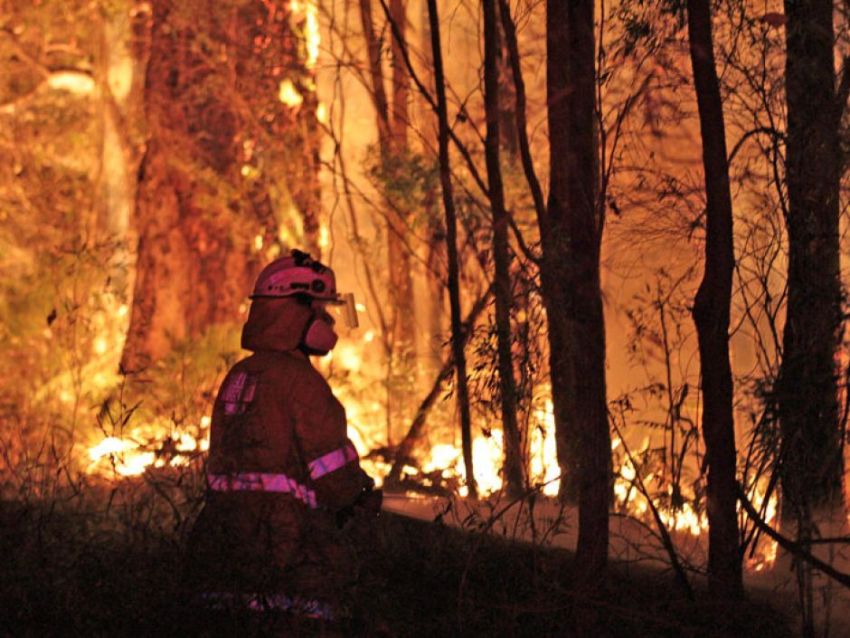
Partly due to luck, and partly due to the heroic efforts of severely overstretched firefighters, the huge bushfires that swept southern Western Australia in early February resulted in no loss of life. These devastating fires also provide a glimpse into our future on a warming planet unless we cut carbon emissions fast.
In the first five weeks of the year alone, WA authorities recorded 3000 separate fires. The largest fire, which threatened the town of Northcliffe, had a 300 kilometre perimeter at its height. It was the biggest fire in the region for more than 50 years. As 130 Victorian firefighters were flown in to help, the state’s Fire and Emergency Services Commissioner said on February 2 that the situation was “somewhat unprecedented in Western Australia”.
Is there a link between these particular bushfires and climate change? The only sensible answer to that is question is yes. Emphatically, yes. All weather is affected by climate change now because climate change is already here.
Across Australia, climate change is already increasing the risk of bushfires and is making the bushfire season longer. As temperatures rise further, so too will the number of days that represent an extreme fire danger.
In its newly released Annual Climate Report 2014, the Bureau of Meteorology (BOM) said last year was Australia’s third-hottest year on record. It said that seven of Australia’s 10 warmest years since records began in 1910 took place between 2002 and 2014.
The BOM said there is no doubt that Australia’s climate is getting steadily hotter: “Warming in the Australian region is very similar to that seen at the global scale, and the past year emphasises that the warming trend continues. Temperatures over Australia have risen by about one degree since the start of last century, with most of the warming occurring since 1950.”
Climate scientists are also getting better at quantifying just how much global warming is changing the climate. A new report by climate scientist Will Steffen, released by the Climate Council on February 5, said new methods are allowing scientists to work out how much climate change has influenced individual heat extremes in Australia.
The report discusses Australia’s warmest-ever year of 2013. Steffen refers to a 2014 study by Sophie Lewis and David Karoly. It concluded that “without the human influence on climate, the record temperature Australia experienced in 2013 would occur only once in 12,300 years”. In essence, this means “the 2013 record would not have occurred in the absence of climate change”.
Another 2014 study compared Australian temperature trends from 1860 to the present. It concluded “the record hot year of 2013 in Australia was virtually impossible without the influence of climate change”.
A third study compared Australia’s 2012/13 “Angry Summer” heatwave with past temperature records going back to 1955. Steffen said the “results showed that there is a ‘calculable’ human influence on the hot Australian summer of 2012/2013”.
These new studies regarding the influence of climate change on single heat extremes come on top of the large and well-established body of research that shows the long-term warming trend. Steffen says that “record hot days have doubled in Australia in the last 50 years, while record cold days have declined by a similar fraction”.
For Australia, the UN Intergovernmental Panel on Climate Change predicts that by 2050 extreme hot days that now take place every 20 years will take place every two to five years.
Without effective action on climate change, Steffen says Australia’s heat extremes will get worse: “Towards the end of the century, the occurrence and intensity of extreme heat will depend strongly on our success, or not, in reducing greenhouse gas emissions, mainly emissions of carbon dioxide.”
If carbon emissions do not fall dramatically, “today’s extreme heat will become commonplace, occurring every summer across the continent in the last decade or two of this century”.
Steffen said the evidence for climate change’s impact on Australia’s heat extremes is overwhelming: “Extreme heat is becoming more frequent and more severe, and climate change is the primary reason.
“The case for action is just as overwhelming. Carbon emissions will need to be reduced rapidly and deeply, with most of the world’s economies essentially decarbonised by the middle of the century, if the climate system is to be stabilised and the worst of extreme heat in the second half of the century is to be avoided.”
[Download the Climate Council Report, Quantifying the Strong Influence of Climate Change on Extreme Heat in Australia]